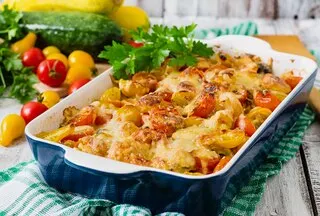Minnesota-Ethiopian Hot Dish Recipe | A Fusion of Ethiopian and Midwest Comfort
Discover the Minnesota-Ethiopian Hot Dish recipe! This one-pan meal blends Ethiopian spices like berbere with Midwest casserole tradition. Perfect for potlucks, vegetarian-friendly, and easy to make.
Minnesota-Ethiopian Hot Dish Recipe
Experience the bold flavors of Ethiopia combined with the hearty comfort of a classic Midwest hot dish. This vegetarian-friendly casserole uses chickpeas, lentils, and Ethiopian spices for a unique, satisfying meal.
Ingredients:
- Creamy Base: 1 can cream of mushroom soup (14 oz)
- Spices: 2 tbsp olive oil or niter kibbeh, 2 tbsp berbere spice blend, 1 tsp cumin, 1 tsp paprika
- Vegetables: 1 large onion (chopped), 3 garlic cloves (minced), 1 tsp fresh ginger (minced), 1 can diced tomatoes (14 oz), 1 can diced carrots (14 oz), 1 can diced potatoes (14 oz), 1 cup chopped spinach, 1/2 can green peas (7 oz)
- Proteins: 1 can chickpeas (14 oz), 1 cup green lentils (rinsed)
- Liquid Base: 2 cups vegetable broth
- Topping: 1/2 cup breadcrumbs or crushed crackers, 2 tbsp niter kibbeh or olive oil
Directions:
- Preheat oven to 375°F (190°C).
- In a large oven-safe skillet, heat olive oil or niter kibbeh over medium heat. Sauté onion until golden (5-7 min). Add garlic, ginger, and toast spices for 2-3 minutes.
- Stir in diced tomatoes, chickpeas, lentils, vegetable broth, carrots, and potatoes. Cover and simmer for 20 minutes until lentils soften.
- Mix in spinach, peas, and cream of mushroom soup. Cook until thickened (5 min). Adjust seasoning.
- For the topping, combine breadcrumbs with melted butter or olive oil. Sprinkle evenly over the hot dish.
- Bake uncovered for 15-20 minutes until the topping is golden and crispy.
Serve warm with injera bread or a side salad for a perfect fusion meal.
- Mozambique Coconut Beans Recipe
- Black-Eyed Pea Casserole with Rice and Herbs
- Rice and Beans Ghana Style
- Fried Banana Rice Dumplings
- Fried Rice Cakes Recipe




























